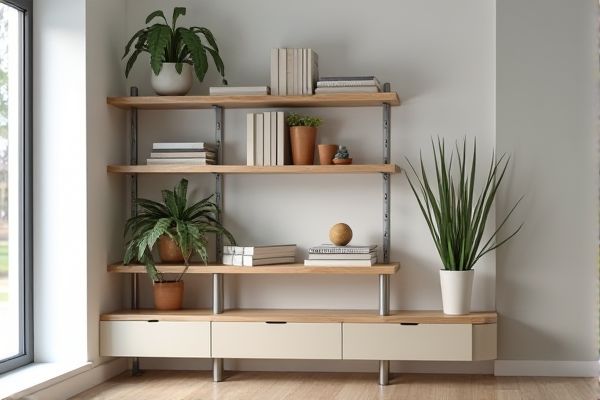
Corner shelving maximizes space utilization by fitting snugly into room corners, providing practical storage without dominating the space. Floating shelving offers a sleek, modern look by attaching directly to walls with hidden brackets, creating an airy, minimalist appeal--explore the rest of the article to find which style best suits your needs.
Table of Comparison
| Feature | Corner Shelving | Floating Shelving |
|---|---|---|
| Installation Location | Fits into room corners, maximizing unused space. | Mounted directly on walls, ideal for open wall areas. |
| Design | Usually L-shaped or triangular, tailored for corners. | Sleek, minimalist, and appears to "float" without visible supports. |
| Space Utilization | Optimizes tight corner spaces effectively. | Offers versatile placement but uses more wall space. |
| Weight Capacity | Generally supports heavier items due to corner support. | May have weight limits depending on anchor type. |
| Aesthetic Appeal | Blends into corners, subtle and functional. | Modern, clean look enhancing wall decor. |
| Common Uses | Books, decorative items, plants in smaller spaces. | Display art, photos, lightweight decor, and small plants. |
| Installation Complexity | Moderate; requires corner mounting and precise measurements. | Easy to moderate; mostly wall mounting with anchors. |
Introduction to Corner Shelving and Floating Shelving
Corner shelving maximizes unused spaces by fitting neatly into room corners, offering a practical storage solution that enhances spatial efficiency. Floating shelving mounts directly to the wall without visible supports, creating a minimalist and modern aesthetic that showcases your items elegantly. Choosing between corner shelving and floating shelving depends on your room layout and design preferences, ensuring your storage complements your interior style.
Space Optimization: Corner vs Floating Shelving
Corner shelving maximizes unused angular space, making it ideal for small rooms or areas with limited wall surface, while floating shelving optimizes vertical space by allowing customizable height and arrangement. Floating shelves create an illusion of openness with minimal visual bulk, enhancing spaciousness in modern interiors, whereas corner shelves efficiently utilize often neglected spots without compromising floor area. Both options contribute to space optimization but target different spatial challenges based on room layout and storage needs.
Design Versatility and Style Comparison
Corner shelving maximizes space by fitting snugly into room angles, offering design versatility with options like L-shaped or triangular units that blend seamlessly into various decor styles. Floating shelving provides a sleek, modern aesthetic with clean lines and an illusion of spaciousness, ideal for minimalist or contemporary interiors. Evaluating your room layout and style preferences helps determine whether corner shelving's functional design or the floating shelves' stylish presence best complements your space.
Installation Process and Practicality
Corner shelving typically requires precise measurements and secure wall anchors to fit snugly into angled spaces, making installation more complex but ideal for maximizing unused corners. Floating shelving offers a straightforward installation with hidden brackets that create a minimalist look and can be placed on any wall, enhancing accessibility and versatility. Both options provide practical storage solutions, with corner shelves optimizing space in tight areas and floating shelves allowing flexible placement for varied storage needs.
Strength and Weight Capacity Differences
Corner shelving typically offers greater strength and weight capacity due to its support from two adjacent walls, making it ideal for heavier items. Floating shelving relies on hidden brackets anchored inside the wall, which limits its weight capacity and often suits lighter decorative objects. Proper installation and wall type significantly influence the load-bearing capabilities of both shelving options.
Best Uses and Applications in Home Spaces
Corner shelving maximizes space in small or awkwardly shaped rooms, making it ideal for kitchens, bathrooms, and living room nooks where wall space is limited. Floating shelving offers a sleek, minimalist look perfect for displaying decor or storing essentials in modern living rooms, bedrooms, and offices without bulky supports. Your choice depends on whether you prioritize space efficiency with corner units or aesthetic versatility with floating shelves.
Cost Effectiveness and Material Options
Corner shelving often provides greater cost effectiveness by maximizing underutilized space with affordable materials like plywood or MDF, making it ideal for budget-conscious projects. Floating shelving offers sleek, modern aesthetics with versatile material options such as solid wood, metal, or glass, though it typically requires more expensive hardware and installation. You can achieve a balance between style and budget by selecting the right shelving type based on your space constraints and material preferences.
Maintenance and Longevity
Corner shelving often requires more maintenance due to its placement, which can collect dust and dirt in hard-to-reach angles, whereas floating shelving, with fewer contact points, typically offers easier cleaning and upkeep. The materials used for corner shelves, often bulkier and sturdier, may enhance longevity but can be susceptible to warping or damage if not properly supported. Floating shelves, especially those made from solid wood or metal, provide durable support with concealed brackets, promoting a longer lifespan when mounted correctly.
Pros and Cons of Corner Shelving
Corner shelving maximizes unused triangular spaces, offering increased storage without occupying central wall areas, making it ideal for small rooms. Its sturdy structure supports heavier items but may limit accessibility and visibility compared to floating shelves. Your choice depends on balancing spatial efficiency with the desired aesthetic and ease of reach.
Pros and Cons of Floating Shelving
Floating shelving offers a sleek, modern design that maximizes wall space without visible brackets, making it ideal for minimalist interiors. Its pros include easy customization, versatility across rooms, and the ability to showcase decor or store essentials securely. However, floating shelves may have weight limitations compared to corner shelving and require proper wall anchoring to ensure stability and prevent damage.
 homyna.com
homyna.com